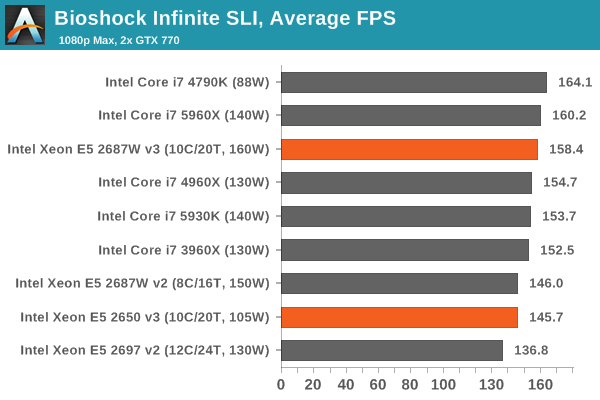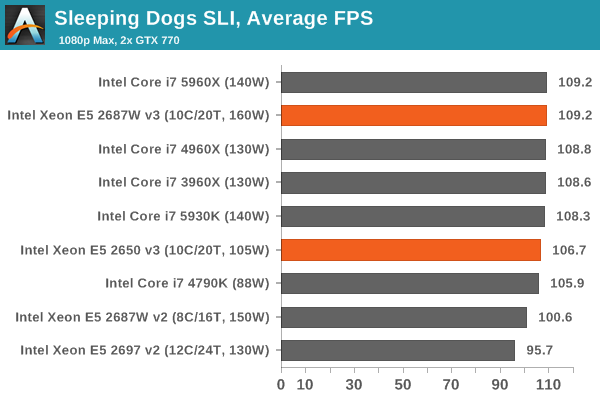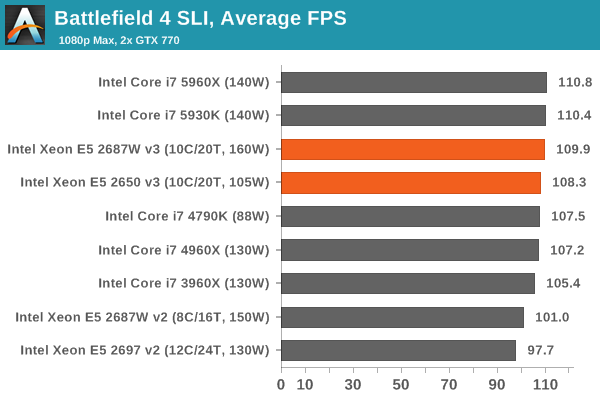Intel Xeon E5-2687W v3 and E5-2650 v3 Review: Haswell-EP with 10 Cores
by Ian Cutress on October 13, 2014 10:00 AM EST- Posted in
- CPUs
- IT Computing
- Intel
- Xeon
- Enterprise
- Enterprise CPUs
Gaming Benchmarks
F1 2013
First up is F1 2013 by Codemasters. I am a big Formula 1 fan in my spare time, and nothing makes me happier than carving up the field in a Caterham, waving to the Red Bulls as I drive by (because I play on easy and take shortcuts). F1 2013 uses the EGO Engine, and like other Codemasters games ends up being very playable on old hardware quite easily. In order to beef up the benchmark a bit, we devised the following scenario for the benchmark mode: one lap of Spa-Francorchamps in the heavy wet, the benchmark follows Jenson Button in the McLaren who starts on the grid in 22nd place, with the field made up of 11 Williams cars, 5 Marussia and 5 Caterham in that order. This puts emphasis on the CPU to handle the AI in the wet, and allows for a good amount of overtaking during the automated benchmark. We test at 1920x1080 on Ultra graphical settings.

Bioshock Infinite
Bioshock Infinite was Zero Punctuation’s Game of the Year for 2013, uses the Unreal Engine 3, and is designed to scale with both cores and graphical prowess. We test the benchmark using the Adrenaline benchmark tool and the Xtreme (1920x1080, Maximum) performance setting, noting down the average frame rates and the minimum frame rates.

Tomb Raider
The next benchmark in our test is Tomb Raider. Tomb Raider is an AMD optimized game, lauded for its use of TressFX creating dynamic hair to increase the immersion in game. Tomb Raider uses a modified version of the Crystal Engine, and enjoys raw horsepower. We test the benchmark using the Adrenaline benchmark tool and the Xtreme (1920x1080, Maximum) performance setting, noting down the average frame rates and the minimum frame rates.

Sleeping Dogs
Sleeping Dogs is a benchmarking wet dream – a highly complex benchmark that can bring the toughest setup and high resolutions down into single figures. Having an extreme SSAO setting can do that, but at the right settings Sleeping Dogs is highly playable and enjoyable. We run the basic benchmark program laid out in the Adrenaline benchmark tool, and the Xtreme (1920x1080, Maximum) performance setting, noting down the average frame rates and the minimum frame rates.

Battlefield 4
The EA/DICE series that has taken countless hours of my life away is back for another iteration, using the Frostbite 3 engine. AMD is also piling its resources into BF4 with the new Mantle API for developers, designed to cut the time required for the CPU to dispatch commands to the graphical sub-system. For our test we use the in-game benchmarking tools and record the frame time for the first ~70 seconds of the Tashgar single player mission, which is an on-rails generation of and rendering of objects and textures. We test at 1920x1080 at Ultra settings.
















27 Comments
View All Comments
TiGr1982 - Wednesday, October 15, 2014 - link
This new workstation CPU, Xeon E5-2687W v3, as we see, is intended for multithreaded software.There are actually workstation CPUs better fitting for singlethreaded software: these are Xeon E3, e.g., Xeon E3-1286 v3 (3.7/4.1 GHz) and slower and cheaper models below it.
These are essentially "professionalized" Core i7s for LGA1150.
Being the same silicon as Core i7s for LGA1150, these E3s have their own downsides, however: only 32 GB of RAM and only 8 MB of L3 cache.
And the really fastest in single threaded tasks is Core i7-4790K at 4.0/4.4 GHz, but it lacks ECC memory support.
hrrmph - Tuesday, October 14, 2014 - link
I would like to encourage Ian and AT in general to continue to split the coverage (as they have been doing recently) for dual-socketed platforms into the "low-end" enthusiast / workstation segment, and the "high-end" more heavy-duty server / enterprise segment.Ian's recent articles hitting this from the "low-end" enthusiast / workstation angle have been really helpful to me, even though I've already been part-time "playing" with dual-socketed systems for some time, both as an educational exercise and a personal curiosity endeavor.
In particular, the effects of NUMA aware software on dual-socketed system performance are of great interest.
I've also noticed a lot of negative feedback to Ian's articles that I think is unwarranted. It's mostly from folks who want Ian to do more complex testing of more complex tasks that are primarily enterprise related. That's all well and good, but as I understand it, that is the job of the "other half" of AT to do.
Ian and AT doing dual-socketed articles on "low-end" Windows builds is exactly what we need to help people know whether or not they would like to "step-up" from X99-E. It also is helpful so that folks know what they are really getting into if they go the dual-socketed route. As Ian pointed out in recent articles there are still some things that X99-E will do better and going into dual-socketed computing all "starry-eyed" isn't necessarily the best way to approach it.
If there is anything that AT could use, it's actually even more comparative testing of X99 Haswell-E versus the C6xx Haswell-EP from a Windows workstation user's perspective. It would be great to see which taskings favored which platform in actual testing.
Everyone has an opinion, but actually doing it is the best way to demonstrate what works and what doesn't.
mapesdhs - Thursday, October 16, 2014 - link
Entirely agree! Good summary.
Btw, disappointing to see the threaded CB R15 result for the 2687W is only 30% better
than an oc'd 3930K (mine @ 4.7 gives 1221). Does confirm that to really best a 1-socket
oc'd i7, one really has to move to a multi-socket platform, and then of course it boils down
to whether the sw is written to match (eg. is Handbrake written as well as it could?)
Ian.
PS. I hasten to add, I'm a different Ian. :D
SanX - Tuesday, October 14, 2014 - link
"And remember this rule Pinnochio for the rest of your life -- two processors with the factor of 1.5 difference are equal"colonelclaw - Wednesday, October 15, 2014 - link
Any chance you could include V-Ray in future benchmarks? It's multi-application and multi-platform and very popular in the CGI world.mapesdhs - Thursday, October 16, 2014 - link
And of course c-ray, which scales extremely well with multiple cores.Ian.
otherwise - Monday, November 17, 2014 - link
In the future, is there any chance you can add a benchmark that stresses single-threaded integer performance? I'd love to see how much Int performance has changed from generation to generation, but most sites (including this one) seem to focus on FP performance.